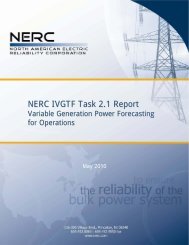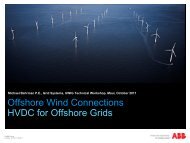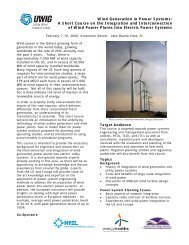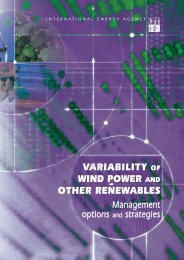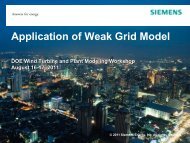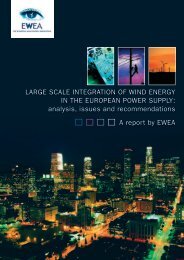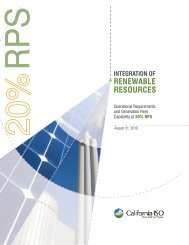Integrating Southwest Power Pool Wind to Southeast Electricity ...
Integrating Southwest Power Pool Wind to Southeast Electricity ...
Integrating Southwest Power Pool Wind to Southeast Electricity ...
You also want an ePaper? Increase the reach of your titles
YUMPU automatically turns print PDFs into web optimized ePapers that Google loves.
more likely <strong>to</strong> be turned off during the night in high wind days when balancing requirements are<br />
shared.<br />
Scenario #4 – Effect of Removing Hurdle Rates<br />
The only difference between Scenarios #3 and #4 is that hurdle rates are removed from Scenario<br />
#4. It was shown previously, that production costs are only slightly reduced with Scenario 4,<br />
while generation was shown <strong>to</strong> change mainly in SPP and SBA. Table 5-11 shows the change in<br />
generation for Scenario #4 relative <strong>to</strong> #3. Hurdle rates around SBA are highest, and therefore<br />
SBA would be expected <strong>to</strong> show the greatest change. SPP increases CC and coal usage as these<br />
are modeled as cheaper (cheaper fuel price, better heat rates assumptions). SBA has<br />
correspondingly more expensive CCs and coal units. This has the effect of increasing <strong>to</strong>tal<br />
interchange in<strong>to</strong> SBA and out of SPP. While removing hurdle rates completely may not be<br />
reasonable or likely (in fact they may increase as more transmission is built for wind), it does<br />
show the bookend of what reduced rates may do in terms of impact of balancing high amounts of<br />
wind.<br />
Table 5-11: Difference** in average generation for Scenario 4 vs. Scenario 3<br />
Change in<br />
SERC SERC<br />
GW EES TVA SBA SPP West East Total<br />
CC 0.12 0.34 (1.05) 0.66 (0.15) (0.01) (0.09)<br />
GT 0.00 0.01 (0.02) 0.00 0.01 0.03 0.02<br />
Hydro - - - - - - -<br />
Nuclear 0.00 - - 0.00 - 0.00 0.00<br />
Coal (0.01) (0.09) (0.57) 0.92 (0.15) 0.01 0.11<br />
Gasoil 0.01 - (0.00) (0.00) - 0.00 0.01<br />
<strong>Wind</strong> - - - - - - -<br />
Other (0.00) (0.01) (0.08) 0.02 (0.00) (0.03) (0.10)<br />
Total 0.12 0.25 (1.72) 1.60 (0.29) 0.00 (0.04)<br />
**Positive value represents increase in generation in Scenario #3 relative <strong>to</strong> Scenario #2.<br />
Scenario #1 Proxy – Effect of Forecast Uncertainty and Increased Reserve<br />
Requirements Associated with <strong>Wind</strong><br />
The scenario 1 proxy uses only the reserve requirements from the 7 GW wind case examined<br />
earlier. Additionally, wind is assumed <strong>to</strong> be perfectly forecast. This case is analyzed <strong>to</strong> evaluate<br />
the balancing costs that wind imposes on the system. While this does not give so-called<br />
‘integration costs’ of wind, it does show the effect of intra-hour variability and uncertainty. This<br />
can be used <strong>to</strong> place other costs in context. As shown earlier, the cost reduction from higher<br />
cooperation across the footprint is larger than that which could be achieved with smaller<br />
balancing areas if wind could be perfectly forecast and had no intra-hour variability.<br />
The change in the average generation between the Scenario #1 and the Proxy case is shown in<br />
Table 5-12. As expected, the largest change is in SPP, which carries all of the intra-hour<br />
reserves for the wind in Scenario #1. Due <strong>to</strong> reduced reserve requirements, SPP CC generation<br />
decreases and coal is increases slightly. Coal also increases elsewhere in the region reducing SPP<br />
exports. Looking at the costs savings shown and placing them in context of savings per MWh of<br />
wind it can be seen that the balancing costs of the wind come <strong>to</strong> approximately $5/MWh, which<br />
5-19




